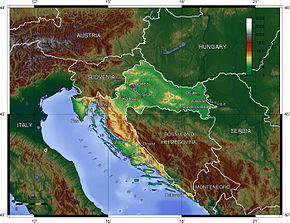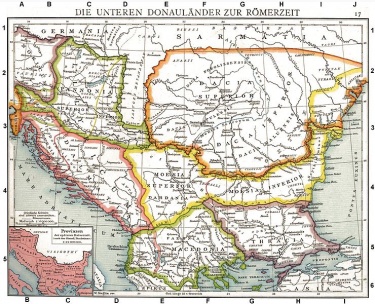Difference between revisions of "Croatian Identity"
(recent DNA studies have stated that more than three quarters of today's Croatian men are the descendants of Europeans who inhabited Europe 13 000-20 000 years ago.) |
|||
| Line 10: | Line 10: | ||
It is also very interesting to note that recent DNA studies have stated that more than three quarters of today's Croatian men are the descendants of Europeans who inhabited Europe 13 000-20 000 years ago. | It is also very interesting to note that recent DNA studies have stated that more than three quarters of today's Croatian men are the descendants of Europeans who inhabited Europe 13 000-20 000 years ago. | ||
== Roman Dalmatia == | == Roman Dalmatia == | ||
| − | [[File:740px-Roman provinces of Illyricum, Macedonia, Dacia, Moesia, Pannonia and Thracia.jpg|thumb|right|375px|The Roman province of Dalmatia (pink | + | [[File:740px-Roman provinces of Illyricum, Macedonia, Dacia, Moesia, Pannonia and Thracia.jpg|thumb|right|375px|The Roman province of Dalmatia (pink colour) in the Western Roman Empire. 476 AD]] |
Slavic tribes invaded the region of [[Dalmatian Italians#Roman Dalmatia |Roman Dalmatia]] in the early Middle Ages. Prior to the arrival of the Slavs, Roman Dalmatia was mainly inhabited by a '''Roman Latin-Illyrian''' population. Sections of the old Roman Dalmatian province became part of the Kingdom of Croatia (925–1102 AD). | Slavic tribes invaded the region of [[Dalmatian Italians#Roman Dalmatia |Roman Dalmatia]] in the early Middle Ages. Prior to the arrival of the Slavs, Roman Dalmatia was mainly inhabited by a '''Roman Latin-Illyrian''' population. Sections of the old Roman Dalmatian province became part of the Kingdom of Croatia (925–1102 AD). | ||
| Line 16: | Line 16: | ||
Contemporary historian Danijel Dzino states that the 19 century theories of mass movements of people into the old Roman Province of Dalmatia are questionable. Modern Archaeological and Scholarly research seems to be saying that we are looking at much smaller groups of Slavs invading the region. According to historians Florin Curta and Danijel Dzino the term Slavs was first used by outside observers of the day to describe the newcomers. The Slavs used the term to describe themselves at a later stage. Thus began the construct identity of the new arrivals. Later the Slavic peoples started to identify themselves and separated (or were separated by others) into different groups. | Contemporary historian Danijel Dzino states that the 19 century theories of mass movements of people into the old Roman Province of Dalmatia are questionable. Modern Archaeological and Scholarly research seems to be saying that we are looking at much smaller groups of Slavs invading the region. According to historians Florin Curta and Danijel Dzino the term Slavs was first used by outside observers of the day to describe the newcomers. The Slavs used the term to describe themselves at a later stage. Thus began the construct identity of the new arrivals. Later the Slavic peoples started to identify themselves and separated (or were separated by others) into different groups. | ||
| − | The issue of dates is an interesting one. Historians from the 18th and 19th century place the ''settlement'' of the Slavs into the Western Balkans in the 7th century but the more modern research undertaken by scholars and archaeologists<ref>[http://books.google.com.au/books?id=6UbOtJcF8rQC&pg=PA52&dq=croatian+graves+medieval+dalmatian+dating&hl=en&ei=LA6HTan-IsGHcYbf3Y4D&sa=X&oi=book_result&ct=result&resnum=1&ved=0CD4Q6AEwAA#v=onepage&q&f=false Becoming Slav, Becoming Croat:] Identity Transformations in Post-Roman and Early Medieval Dalmatia by Danijel Dzino (p52).</ref> cannot confirm this. The arrival and settlement of the Slavs by some has now been thought to be more in the region of the 8th century or even early 9th century. | + | The issue of dates is an interesting one. Historians from the 18th and 19th century place the ''settlement'' of the Slavs into the Western Balkans in the 7th century but the more modern research undertaken by scholars and archaeologists<ref>[http://books.google.com.au/books?id=6UbOtJcF8rQC&pg=PA52&dq=croatian+graves+medieval+dalmatian+dating&hl=en&ei=LA6HTan-IsGHcYbf3Y4D&sa=X&oi=book_result&ct=result&resnum=1&ved=0CD4Q6AEwAA#v=onepage&q&f=false Becoming Slav, Becoming Croat:] Identity Transformations in Post-Roman and Early Medieval Dalmatia by Danijel Dzino (p52).</ref> cannot confirm this. The arrival and ''settlement'' of the Slavs by some has now been thought to be more in the region of the 8th century or even early 9th century.<ref>'''Editors''' note: The early sources must have reflected the raid actively of the Slavic tribes.</ref> |
==See also== | ==See also== | ||
Revision as of 03:51, 30 June 2011
The first primary source (factual) to mention the Croatian (Hrvat) identity in the Balkans was Prince Branimir (Latin: "Branimiro comite dux cruatorum cogitavit" c. 880 AD).[1][2] Prince Branimir was a Slav from Dalmatia. Hrvat or Horoúathos are names of Sarmatian origins. In 1853 a Russian archaeologist Pavel Mikhailovich Leontjev discovered the Tanais Tablets. The Tanais Tablets mention three men: Horoúathos, Horoáthos, and Horóathos (Χορούαθ[ος], Χοροάθος, Χορόαθος). They are written in Greek and are from the 3rd century AD from the city of Tanais, today's Azov, Russia. At that time the region had a mixed Greek - Sarmatian population.
The term Slav was first used by the Byzantines-Eastern Roman Empire (i.e. Procopius-Byzantine scholar, Jordanes- 6th century Roman bureaucrat) and was recorded in the 6th century (cia. 550) in Greek (Σκλαβῖνοι-Sklabenoi). Later in Latin it was written Sclaveni.
From the information above one can conclude that we are dealing with a union between Slavic and Sarmatian tribes in the very early middle ages.
It is also very interesting to note that recent DNA studies have stated that more than three quarters of today's Croatian men are the descendants of Europeans who inhabited Europe 13 000-20 000 years ago.
Roman Dalmatia
Slavic tribes invaded the region of Roman Dalmatia in the early Middle Ages. Prior to the arrival of the Slavs, Roman Dalmatia was mainly inhabited by a Roman Latin-Illyrian population. Sections of the old Roman Dalmatian province became part of the Kingdom of Croatia (925–1102 AD).
Contemporary historian Danijel Dzino states that the 19 century theories of mass movements of people into the old Roman Province of Dalmatia are questionable. Modern Archaeological and Scholarly research seems to be saying that we are looking at much smaller groups of Slavs invading the region. According to historians Florin Curta and Danijel Dzino the term Slavs was first used by outside observers of the day to describe the newcomers. The Slavs used the term to describe themselves at a later stage. Thus began the construct identity of the new arrivals. Later the Slavic peoples started to identify themselves and separated (or were separated by others) into different groups.
The issue of dates is an interesting one. Historians from the 18th and 19th century place the settlement of the Slavs into the Western Balkans in the 7th century but the more modern research undertaken by scholars and archaeologists[3] cannot confirm this. The arrival and settlement of the Slavs by some has now been thought to be more in the region of the 8th century or even early 9th century.[4]
See also
References
- ^ 'Becoming Slav’, ‘Becoming Croat’: New approaches in research of identities in post-Roman Illyricum by Danijel Dzino
- "The first evidence of the Croat name, dux/rex Croatorum, does not appear until the ninth century. The Charter of Duke Trpimir is indeed the oldest text that mentions the Croat name, dux Chroatorum but its authenticity is disputed for good reason.The earliest certain evidence is the title dux Cruatorum from duke Branimir's inscription (c. 880), so that before this date we cannot assume with certainty that the Croat identity existed at all."
- ^ A History of the Croatian Language: by Milan Mogus (p.13)
- ^ Becoming Slav, Becoming Croat: Identity Transformations in Post-Roman and Early Medieval Dalmatia by Danijel Dzino (p52).
- ^ Editors note: The early sources must have reflected the raid actively of the Slavic tribes.
<sharethis />


